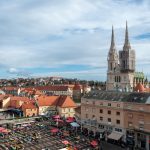Year-round tourism is a term on everyone’s lips, but just how do we go about actually achieving it?
As Marija Crnjak/Poslovni Dnevnik writes on the 9th of September, 2018, at the end of this month in Zagreb, the second edition of the ”Može li hrvatski turizam 365” (Can Croatian tourism last 365 [days per year]) conference will be held.
This was a perfect occasion for Poslovni Dnevnik to sit down and talk to Ivana Kolar, the organiser of the conference, who, after a rich management career, decided to launch her own company ”Julius Rose” for business consulting, and all-year-round tourism is certainly one of the biggest challenges currently facing the tourism industry here in Croatia.
What do you expect from the second edition of the conference, in what way will it differ from last year?
The first conference opened up many questions related to our potential and our opportunities, and this year we’ll delve deeper into that issue and into the exploration of the basic preconditions for year-round tourism.
Our goal is to present and discuss the potential domestic tourism holds for all-year-round business, opportunities, positive practices, and most of all, the solutions to extend it from the coast and to initiate tourism development towards the continental part of the country. The conference will, through presentations, examples of good practice and panel discussions from domestic and regional professionals from Austria, Slovenia, Hungary, Portugal and Bosnia and Herzegovina, offer new knowledge and ideas for small and medium-sized enterprises, entrepreneurs, and business owners.
Can we be satisfied with the current dynamics of the extension of the tourist year?
The problem is being all the more actualised, or better to say, the challenge, the season extension… but that doesn’t mean that we’ve got year-long business. Individual destinations have recognised the potential of working for longer and there are good examples that show that this is possible in Croatia, but there’s still a lot of work ahead of all of those of us who want it to achieve all-year-round tourism. The potential is extremely big, and neighboring countries show us through their example(s) that tourism 365 is achievable and that a high tourism result can be achieved via year-round business, and most of all through sustainability.
Why have we not managed to arrive to meaningful results yet, what are the specific reasons for that?
I believe that the main reason for the insufficient activities and the lack of serious development of initiatives for both the season and for year-round tourism without a clear goal is whether or not we want it, and how then do we achieve it.
If we decide that we want to work on significant growth in the remaining months [outside of summer], and especially in the continental part of Croatia, then we’ll have to strategically approach it and manage the necessary developments and changes.
The summer season is always great and it’s relatively easy to come to the results that satisfy the majority, and for more in the other parts of the year, a significant investment is needed, primarily in terms of work/business. I guess that many people are satisfied with their several month-long business and that they lack the desire and the motivation for year-round tourism. For all-year tourism, much more work and a different approach than the one used for summer or ”sun and sea” tourism is needed, and it’s safe to start counting on less revenue during those other parts of the year at the beginning.
However, if all this is accompanied by raising the quality of the offers and services, the development of new products that do not require the sea, and the openness of hotels and other accommodation, as well as the accompanying content within the destination, a good result in the long term will surely not be missed.
Is this the responsibility of the local community or of the central state, are you satisfied with the implementation of the tourism strategy?
The responsibility lies with everyone involved in the tourism process. Cooperation between politicians, entrepreneurs and residents, both at a local and at a national level, as well as determination and perseverance, and especially creativity and originality, are all needed. Tourism needs to be developed together, and the direction of its development must be influenced by the state and its vision, as well as by the strategic encouragement of development where it’s weaker, especially in continental regions, and by guiding the general development, the entrepreneurs and the large(r) companies with an initiative to develop their products and raise their quality and their desire for the prolongation of the season.
In the long-term, only a longer season will allow for the further growth of destinations and then more revenue growth. Mass tourism over three months is certainly not a long-term solution for Croatia. Longer seasons and year-round tourism, where possible, will affect both the quality and security of staff and the quality of service, as well as ensure sustainability. People need to be animated, educated and encouraged, and there needs to be a link between other activities such as agriculture, production and traffic, and tourism.
The basis for Croatian tourism still lies within private accommodation, which is expanding far faster than hotels are, what does that mean for the 365 concept?
It depends on which side you’re looking at it from. For tourism 365, it’s good, because small renters and small private hotels can easily and quickly adapt their business for a longer period of time. They can quickly connect and network. They can connect with the providers of other tourism services and create very interesting service packages, build new motives for getting to the destination(s) in some other parts of the year, and offer the authenticity of the destination with much more ease than major systems are able to. On the other hand, it seems to me that there’s the least amount of motivation to lengthen their working time or do any of that in this segment.
Can 365 exist without a larger number of hotels?
Tourism 365 can be realised in the way in which it has been conceived and acheived if it’s desired, but I don’t see why it would not be able to do so without a larger number of hotels? There are enough hotels in Croatia that are ready for year-round business in terms of infrastructure, but they’re missing [tourism] products to make things work properly in terms of year-round tourism. Forcing 365 into any destination isn’t the point, but [the point is] to develop a destination in that direction where there are existing preconditions for that, and where there is a desire for it.
Togetherness [working together] is necessary for that, because nobody can decide to go it alone, but that must be the goal of the entire destination. At the first conference, we talked about who must be the initiator of the change – hotels, the local community, the state, or someone else. This is almost irrelevant, it’s important that there is a desire for doing business for a longer period, then it’s necessary to unite forces, develop the potential and the advantages, create new products based on heritage, culture, authenticity, nature, and then ensure availability and connectivity. That can be a good path to take.
Can 365 exist without tourism on the continent?
The 365 concept is available in many locations and destinations along the Adriatic, even on the islands, but it’s necessary to create a destination that can offer content that will be interesting for a number of months or even throughout the year. Tourists travel more and more throughout the year, not just during the summer.
There are destinations, which, by their activities and their product development, have shown that a destination can be attractive in the 365 [model], such as Zagreb, Split, the whole of Istria, Zagorje, Međimurje, and others. I think it would be very interesting to seriously connect the continent and the coast and offer guests services and trips to the continental, green Croatia while on holiday on the Adriatic, given the fact that everything is so closely located to each other in Croatia. Perhaps it would be easier for tourists to visit Croatia once more during the same year, but at some other point in time.
What about holidaying by the sea in winter? Aren’t Adriatic destinations designed just for summer tourism?
Not necessarily. Split is wonderful for all twelve months of the year. Istria also, as are Dubrovnik, Lošinj, and many other destinations.
There are a lot of [tourism] products that can be organised and offered along the coast, if not during all twelve months, then at least during most of the year – wellness and various forms of health tourism, sport, adventure activities, fishing, nature schools for both big and small [people], it’s also important to connect with the hinterland, our country is so diverse and we really offer only a very small part of the potentials it boasts.
I’m pleased that some of the destinations have already started heading in that direction, into the unexplored waters of all-year-round tourism, and some have realised that it’s necessary to present the first such offer to tourists while they’re still on their summer holidays. For example, Pag’s tourist board has recently advertised its beach-free offer and activities in winter jackets for the first time – Moonlight cycling, it’s a really big breakthrough.
Unfortunately, we’re still perceived as a country for cheap summer holidays, although Croatia is no longer just that, especially after all the realised investments over the last few years. However, we need to make a significant contribution to [altering] this perception with strategically designed advertising which should begin while the [summer] tourists are still actually in Croatia. Because, those who spend their summer here, who know how to come to Croatia, they like it here, this is the first market we should offer a stay in Croatia during another part of the year, and invite them to return even before next summer.
With which countries can we compare when it comes to the development of all-year-round tourism? What do the Slovenes and the Austrians have that we don’t?
Obviously, they don’t have what we have, so they’re forced to develop what they do have, and that’s the continent, cities, forests, health, sports, relaxation, heritage, nature. We have a beautiful sea which is a magnet for tourism itself, but for this reason, we’ve neglected the tourist development of the rest of the country and the development of the country’s supply during the remainder of the year [outside of summer].
Slovenia has achieved outstanding results in the presentation of its country and then on the ground, they’ve based it on nature, health, sustainability and excellence, precisely the products that are currently the trend and are growing in terms of international tourism. Austria decided many years ago that it will stop supporting the development of facilities and destinations that don’t operate throughout all 12 months of the year. Today, those running the famous ski resorts have the best results in the summer months during which they’ve developed sport, nature and health products. Of course, we can learn a lot from their examples.
Which niche is the most developed, with which we can ”pull” the continent?
Health tourism, cultural, sports, education, adventure tourism, festivals, manifestations, the potential is huge.
But on the continent, things are often a bit too weak for more serious activities and more serious investments. Proper government assistance, the co-financing of the development of key offers, educational assistance and targetted consultation would certainly improve the situation and encourage better inclusion in the tourism process. There are destinations that are like green islands, but whose visions, perseverance, and creativity have influenced the development of serious tourist stories. Zagorje is an excellent example for this, as are Varaždin and several other places. But for the further and faster development and the promotion, proper help and support would be very welcome.
Click here for the original article/interview by Marija Crnjak for Poslovni Dnevnik








